PROFILE - Walt Disney Leadership Style

Walt Disney, the man behind the magical world of Disneyland and iconic characters like Mickey Mouse, was a legendary figure whose leadership style has left a lasting impact on the world of entertainment.
Walt Disney Enterprises, formed during Walt Disney's early career, exemplified his expectations of excellence and his transformational leadership style. His unique blend of autocratic and transformational leadership, known as the “Walt Disney leadership style,” allowed him to drive innovation while fostering a creative and motivated workforce.
In this blog post, we will delve into the intricacies of Walt Disney’s leadership style, explore his journey through adversity, and uncover the lessons we can learn from this extraordinary leader.
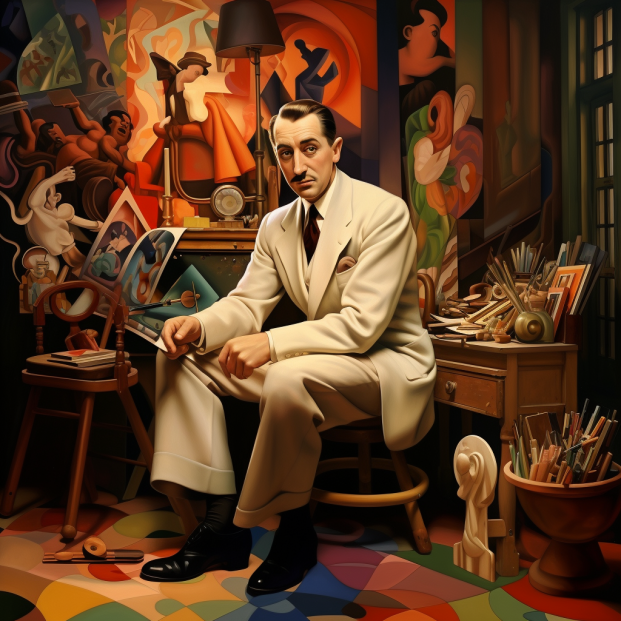
Key Takeaways
- Disney overcame adversity to refine his leadership style and showcase groundbreaking innovations, launching an art school that has nurtured talent.
- The Disney Method is a creative strategy which combines Dreamer, Realist & Critic perspectives for successful problem-solving.
- Walt's legacy of persistence inspires others with its magical impact on creativity & innovation.
Deciphering Walt Disney's Commanding Leadership Approach
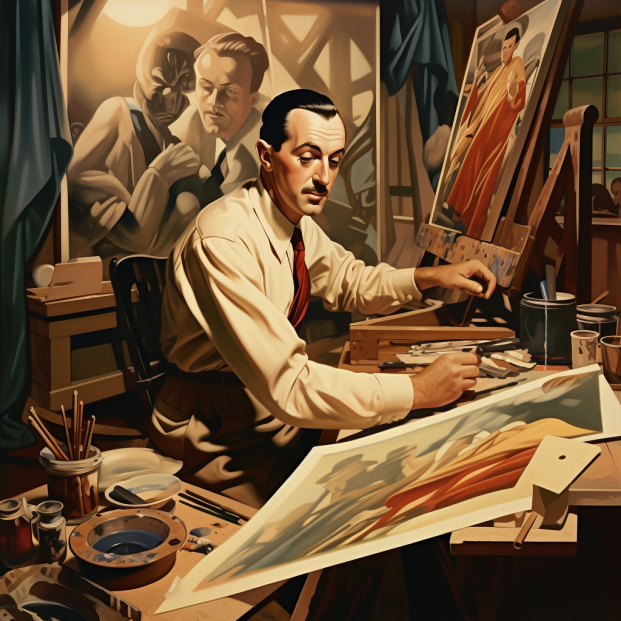
Walt Disney’s leadership style was a fascinating mix of autocratic and transformational approaches. This combination allowed him to drive innovation, while also instilling fear and respect in his employees. Many people found his enthusiasm motivating, enjoying working with someone who had such a clear vision and knew how to reach goals.
Disney would often get upset when projects weren’t being completed to his standards. He wanted progress to happen quickly and flawlessly. This complex leadership style helped Disney create a new entertainment art form – animation – leading to the production of numerous successful animated films.
While his commanding leadership style was effective, one must acknowledge that Walt Disney’s autocratic approach might not align with modern business environments, which often emphasize open-door policies and employee feedback. Nevertheless, his vision and determination led to the creation of iconic amusement parks like Disneyland and Disney World. Disney Parks play a crucial role within The Walt Disney Company, influencing global operations through strategic planning and management of theme parks, resorts, cruise lines, and other related experiences and products.
The Autocrat at Work: Driving Innovation and Fear
Disney demonstrated his autocratic style in the initial days of the Disney Brothers Studio, co-founded with his brother Roy. Here, he adopted cutting-edge animation techniques, such as cutout animation, after working at the Kansas City Film Ad Company.
The creation of the beloved character Mickey Mouse, invented by Ub Iwerks, further showcased Disney’s innovative spirit. However, this autocratic approach also contributed to a tense work environment. Employees feared Disney’s fiery demeanor, and he often dismissed counterarguments without much effort to resolve conflicts.
To ensure that staff were suited to their roles and consistently playing their part in the story, Disney University was created to train the theme park's staff and indoctrinate them into the Disney philosophy.
The animators’ strike in 1941 at The Walt Disney Company marked a significant shift in Disney’s leadership style. The strike, prompted by animators’ desire for better working conditions and fair wages, led to Disney firing many of his animators. Eventually, he was pressured into recognizing the Screen Cartoonists Guild. This event forced Disney to reevaluate his leadership style and adopt a more strategic and management-oriented approach in the years following the strike.
From Strike to Strategy: Overcoming Adversity Post-1941 Animators' Strike
Disney's leadership journey took a significant turn with the animators' strike in 1941. The strike, driven by animators' demands for better working conditions and fairer wages, forced Disney to confront the harsh realities of his autocratic leadership style. In response to the strike, Disney fired many of his animators but ultimately recognized the Screen Cartoonists Guild under pressure. This experience led to a shift in his leadership approach, transforming it from a creative-focused style to a more management-oriented one.
In the wake of the strike, Disney implemented bold strategic changes in his leadership style and management approach. He learned valuable lessons from this challenging period, using his experience to refine his leadership skills and better navigate future obstacles. His commitment to innovation and his unwavering belief in his creative vision continued to drive the company forward, even in the face of adversity.
Embracing New Horizons: Walt Disney and the 1964 World's Fair
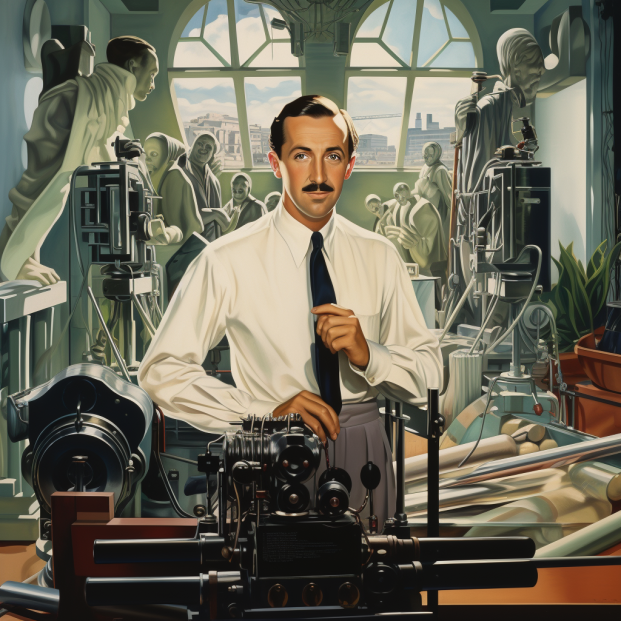
The 1964 World's Fair in New York highlighted Disney's groundbreaking innovations, particularly the company's advanced audio-animatronics technology. The fair included several Disney attractions, such as Ford's Magic Skyway and ‘it's a small world,' which captured the attention and imagination of fairgoers.
The fair also marked the debut of the first human Audio-Animatronic figure, Abraham Lincoln, representing a major technological breakthrough and further solidifying Disney's innovative reputation.
The significant success and popularity of Disney's exhibitions at the 1964 World's Fair underscored the company's ability to remain innovative and forward-thinking. The fair's accolades boosted Walt Disney's confidence, reinforcing his belief in the power of imagination and creativity to captivate audiences and create lasting memories.
The Evolution of a Leader: Walter Elias Disney - Journey Through Adversity
Throughout his life, Walter Elias Disney, commonly known as Walt Disney, encountered a variety of challenges, including financial difficulties and creative hurdles. Despite these hurdles, he persevered and eventually achieved success with the creation of Mickey Mouse and Disneyland.
His leadership style evolved during World War II as he became involved in the production of propaganda films for the U.S. government, developing a more transformational leadership style that motivated his employees to go above and beyond expectations.
Walt Disney's steadfast belief in his dreams and his ability to overcome obstacles inspire leaders across various fields. His tenacity and resilience were key factors in his enduring impact on the world of entertainment and the growth of The Walt Disney Company. Walt's life serves as a testament to the power of perseverance and determination.
The Early Struggles and World War II Challenges
During World War II, Walt Disney faced significant financial struggles due to the animators' strike and the disruption of the international market for his films and merchandise. The performance of Pinocchio, Fantasia, and Bambi during wartime had far-reaching consequences for Disney's business.
Making Bambi, based on a book banned by the Nazis, led to the loss of access to movie theaters in Nazi-controlled territories, forcing Disney to find alternative ways to distribute their films and reach audiences during the war.
Disney's work in producing military training films during the war significantly influenced his subsequent productions. This experience allowed him to refine his skills in storytelling and animation techniques, which he later applied to his feature films and animated shorts.
Additionally, the creation of propaganda and educational films during the war taught Disney about the power of media in shaping public opinion and impacted his approach to storytelling and messaging in his later productions.
The Television Pioneer: Broadening the Brand's Appeal
As The Walt Disney Company grew, Walt Disney recognized the potential of television as a medium to expand his brand's reach and connect with a wider audience. Disney pioneered several groundbreaking television shows, including ‘The Mickey Mouse Club' and ‘Disneyland,' which showcased his ability to create original programming that both entertained audiences and promoted his other projects.
The introduction of television content allowed Disney to reach a larger audience and diversify their revenue streams, generating income from television shows in addition to movies, theme parks, and consumer products.
Disney's television content was highly praised and popular among viewers, demonstrating his commitment to creating heartwarming content that appealed to a diverse range of audiences.
Realizing a Dream: The Creation of Disney World
Walt Disney’s dream of creating Disney World in Florida was finally realized, building on the success of Disneyland in California. The process of creating Disney World was fraught with challenges, such as the high cost of construction, finding a suitable location, and infrastructure-related issues.
However, Disney’s bold vision for the park, which included more space for expansive nature landscapes and was built on a much larger scale than Disneyland, ultimately came to life.
Disney’s ability to turn his dreams into reality was made possible through a combination of:
- Corporate cash
- Financing from banks
- Proceeds from his new venture called WED Enterprises
- Funding through a TV contract negotiated by his brother Roy Disney
The creation of Disney World serves as a testament to Walt Disney’s unwavering persistence and Walt’s enthusiasm, both of which contributed to his commitment to creating magical experiences for generations to come. The Chairman of Disney Experiences oversees Disney Parks, including Walt Disney World Resort, and Disney Signature Experiences, which offers family travel and leisure experiences beyond the theme parks.
Inspirational Leadership: Disney's Transformational Impact
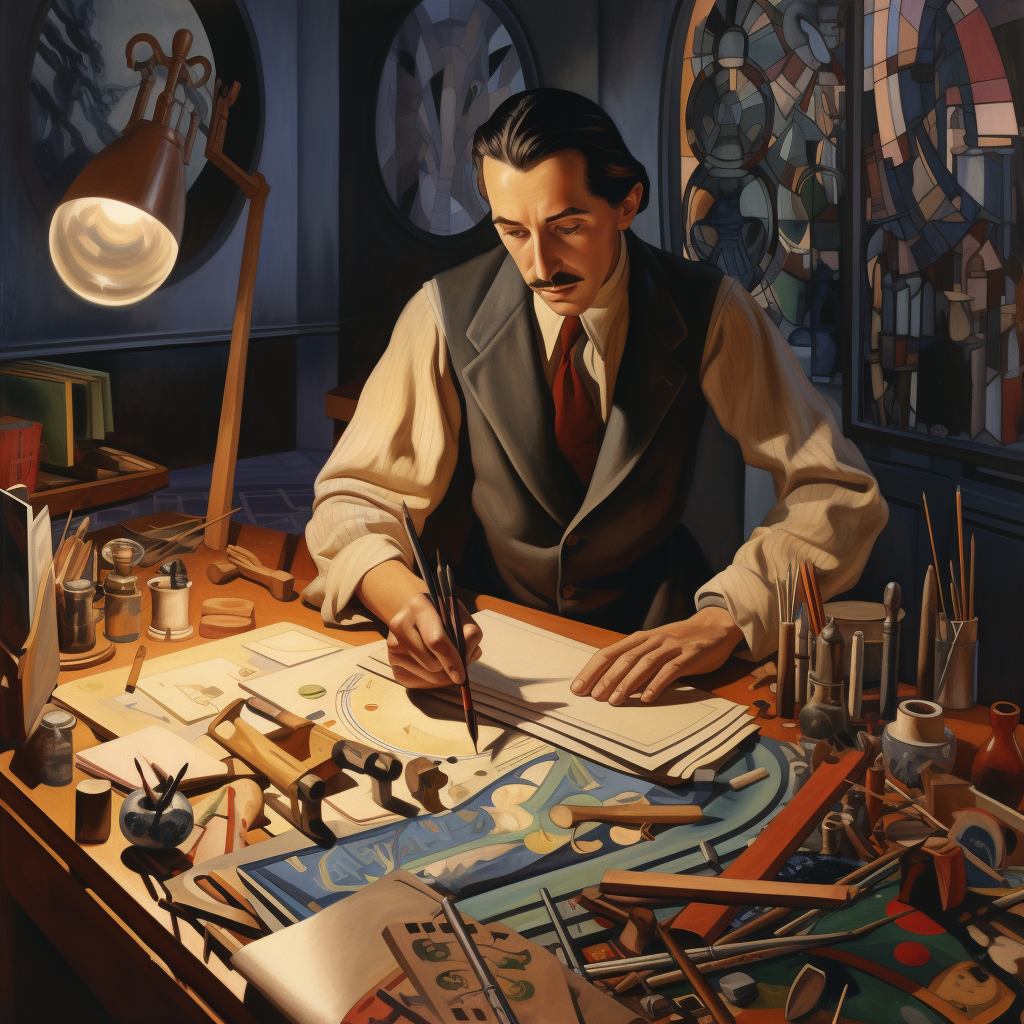
Walt Disney was a transformational leader whose leadership style inspired, motivated, and stimulated his followers intellectually to work towards a common goal. By creating a supportive and motivating work environment, Disney fostered talent within his company and helped his employees reach their full potential.
He also excelled in balancing his public charisma with his private personality, motivating people through his enthusiasm for art and technology while maintaining a more private and reserved demeanor in his personal life.
Disney's steadfast belief in his dreams and his ability to overcome obstacles inspire leaders across various fields. His tenacity and resilience were key factors in his enduring impact on the world of entertainment and the growth of The Walt Disney Company.
Nurturing Talent: The Launch of an Art School
To maintain consistency in his films, Disney established the California Institute of the Arts, aimed at developing his employees' skills. The in-studio training program focused on practical skills and hands-on experience, going beyond the static poses taught in typical art schools.
This approach allowed Disney to maintain a consistent artistic style throughout his films and solidified his reputation for exceptional storytelling and animation.
Notable alumni from Disney's art school include:
- Tim Burton
- Alison Brie
- David Hasselhoff
- Ed Harris
- Sofia Coppola
- Michael Richards
- John Lasseter
The success of these artists, as well as countless others who studied at the California Institute of the Arts, highlights the impact of Disney's commitment to nurturing talent and fostering a supportive and motivating work environment.
The Charismatic Facade: Public Enthusiasm vs. Private Personality
Despite his more private and reserved personality, Disney's public charisma and enthusiasm for art and technology captivated and inspired those around him. He approached public speaking with confidence, authenticity, and a focus on entertaining his audience with amusing anecdotes, further contributing to his public charisma. However, not all of his employees considered him to be charismatic.
Disney's magnetic public persona was sparked by his zeal for his work, his capacity to engage with people, and his talents as a speaker. He cultivated an amiable and extroverted image in the public sphere, which, along with his unwavering persistence and innovative spirit, contributed significantly to his success as a leader.
The Disney Method: A Creative Leadership Strategy
The Disney Method, a creative leadership strategy, involved balancing different thinking styles to turn ideas into reality. This unique method incorporated the entire group of four thinking styles:
- Outsiders
- Dreamers
- Realizers
- Critics
By coordinating these subprocesses, Disney was able to transform his ideas into tangible creations and effectively manage the risks associated with implementing new ideas.
Disney's ability to balance different perspectives, visualize designs, and solve problems effectively contributed to his success as a leader and the enduring impact of his creative vision. The Disney Method continues to serve as an inspiration for leaders and creative thinkers in various industries, demonstrating the power of a balanced and innovative approach to problem-solving.
Dreamer, Realist, Critic: Balancing Perspectives
The Disney Method included the perspectives of dreamer, realist, and critic to create a balanced approach to problem-solving. The three stages are:
- Dreamer: Focuses on generating creative ideas and solutions.
- Realist: Involves evaluating and refining those ideas to make them more practical.
- Critic: Involves rigorously evaluating the ideas and asking tough questions to ensure their viability.
By adopting these three distinct thinking roles, Disney was able to balance different perspectives and consider both the possibilities and limitations of his ideas.
Disney's mastery of the dreamer, realist, and critic approach allowed him to turn his dreams into reality and led to the creation of iconic characters, theme parks, and groundbreaking animated films. This approach helped him to visualize designs, solve problems effectively, and create innovative and successful projects that have left a lasting impact on the world of entertainment.
Implementing the Vision: Turning Ideas into Reality
Disney's ability to implement his vision and embrace new technologies played a key role in his success as a leader. He applied the Disney Method to generate and validate new ideas and implementation plans, allowing him to transform his ideas into tangible creations. Disney's commitment to innovation, attention to detail, and perseverance also contributed to the realization of his creative vision.
Disney introduced cutting-edge technologies such as:
- Monorails
- PeopleMover systems
- Computer vision
- Artificial intelligence
- Virtual reality
- Digital leadership
to implement his vision. His unwavering persistence and commitment to creating magical experiences helped establish Disney as a global entertainment powerhouse and continue to inspire generations of leaders and creative thinkers.
Disney's Legacy: Lessons in Leadership from the Walt Disney Company to Mickey Mouse
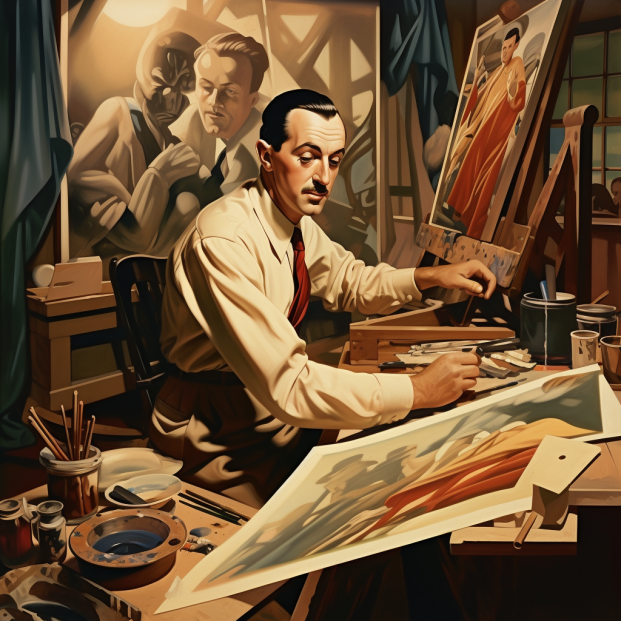
Walt Disney's legacy offers valuable lessons in leadership, including:
- The importance of adapting autocratic styles
- The power of persistence
- Clear vision
- Exemplary communication skills
- Remarkable people skills
- Boldness
- A humble heart
These qualities made him a charismatic leader, an inspirational figure who transformed the entertainment industry. Disney's steadfast belief in his dreams and his ability to overcome obstacles inspire leaders across various fields.
Disney's leadership style evolved over time, incorporating elements of charismatic and transformational leadership as he faced various challenges and opportunities. By learning from the past and adapting his autocratic leadership style, Disney demonstrated the importance of flexibility and resilience in the face of adversity.
His tenacity and resilience were key factors in his enduring impact on the world of entertainment and the growth of The Walt Disney Company.
Learning from the Past: Adapting Autocratic Leadership
Walt Disney adapted his autocratic leadership style by incorporating elements of charismatic and transformational leadership, understanding the importance of inspiring and influencing his team, creating trust, and aligning operations with the company's vision. Some of the advantages of this leadership style include clear direction and vision, and efficient decision-making, while disadvantages include a lack of employee empowerment and potential for burnout.
Disney's ability to adapt his leadership style and learn from past experiences allowed him to overcome obstacles and achieve significant success in the entertainment industry. Some key factors that contributed to his success include:
- Unwavering persistence and determination to create unique and captivating experiences
- Development of iconic characters, theme parks, and groundbreaking animated films
- Ability to enchant audiences worldwide
The Magic of Persistence: Walt's Enduring Impact
Disney's unwavering persistence in Walt's career played a significant role in his enduring impact on the world of entertainment and the growth of The Walt Disney Company. His relentless pursuit of his dreams and his ability to overcome obstacles serve as a reminder of the importance of perseverance in the face of adversity.
Throughout his career, he faced numerous challenges, such as financial setbacks, creative struggles, and the need to acquire vast amounts of land for projects like Disney World. He overcame these obstacles through hard work, perseverance, and a belief in his dreams.
The success of Disneyland and Disney World, as well as countless other creative endeavors, demonstrates Walt Disney's unwavering persistence and his commitment to creating magical experiences for generations to come. His tenacity and resilience continue to inspire leaders and creative thinkers in various industries, demonstrating the power of a balanced and innovative approach to problem-solving.
Summary
Walt Disney's unique blend of autocratic and transformational leadership styles allowed him to drive innovation, foster a creative and motivated workforce, and overcome numerous challenges throughout his career. His unwavering persistence, visionary approach, and ability to adapt his leadership style in the face of adversity serve as an inspiration for leaders in all industries.
As we continue to explore the fascinating world of leadership, let us remember the timeless lessons we can learn from the remarkable life and enduring impact of Walt Disney.
Frequently Asked Questions
What are the leadership theories of Walt Disney?
Walt Disney was a Transformational leader; he inspired trust and admiration from his staff, motivated them to support his vision for the company, and stimulated their intellectual curiosity. He established himself as an authority figure while providing support and guidance to those under his command.
What are the leadership lessons from Walt Disney?
Disney's legacy provides us with four key leadership lessons: Chase your dream, believe in yourself, go big or go home, and don't lose sight of what you are. These timeless pieces of wisdom can help develop any leader's personal skills.
What are Walt Disney's 5 qualities?
Walter Elias Disney was an innovator, a dreamer and an exceptional leader, possessing vision, communication skills, people skills, boldness and a humble heart - qualities which have enabled him to become one of the most successful entrepreneurs of all time.
How did Walt Disney's leadership style evolve over time?
Disney's leadership style evolved over time to encompass both charismatic and transformational elements, adapting to challenges and opportunities he encountered.
What was the Disney Method?
The Disney Method is a powerful strategy that harnesses four distinct thinking styles - Outsiders, Dreamers, Realizers, and Critics - to create innovative solutions.



